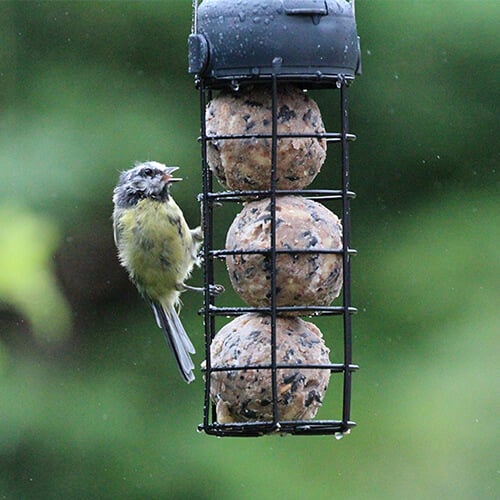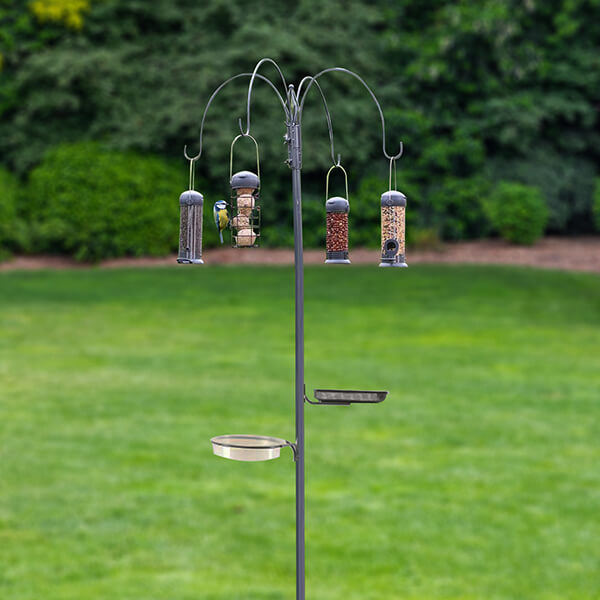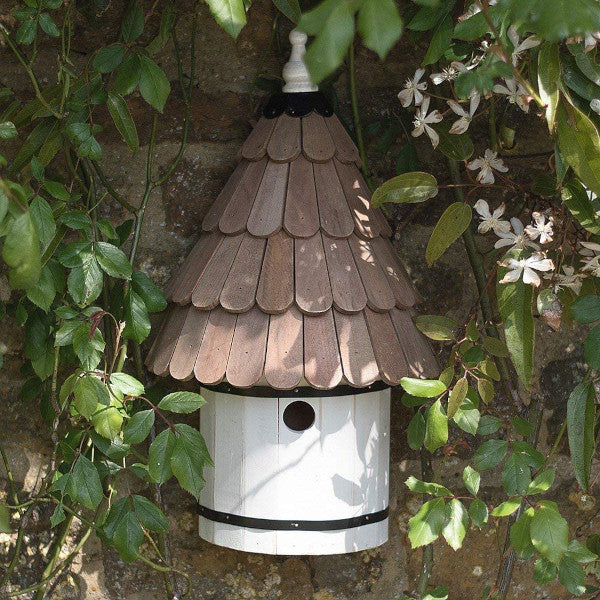How Do Birds Survive In The Winter?
As the days grow shorter and the temperature drops, the arrival of winter heralds a period of immense challenge for the avian inhabitants of our landscapes. Unlike mammals, wild birds lack the luxury of thick fur coats or cozy dens to shield them from the cold. Instead, they must rely on a combination of behavioural adaptations and physiological changes to navigate the harsh realities of winter survival.
Surviving the Cold: A Constant Battle
For birds, winter's chill is more than just an inconvenience—it's a life-threatening adversary. The plummeting temperatures can cause a bird's body temperatures to drop dangerously low, leading to hypothermia and even death. To combat this, wild birds have evolved an array of strategies to minimise body heat loss and maintain their internal temperature.

Energy Management: The Balancing Act
Surviving winter is not just about staying warm; it's also about conserving energy. With food sources scarce, birds must be careful not to exhaust their energy reserves too quickly. They become adept at lowering their metabolic rate and entering periods of torpor—temporary hibernation-like states that allow them to conserve precious energy during the coldest parts of the day or night. We discuss this in more detail below.
Do Birds Shiver?
Birds have a unique way of regulating their body temperature that differs from mammals like humans. While birds do not shiver in the same way mammals do, they have several physiological and behavioral mechanisms to maintain their body temperature in cold weather.

Human Impact: Providing a Helping Hand
In this struggle for survival, humans can play a pivotal role. By offering supplementary food sources through bird feeders and providing accessible water, we can alleviate some of the challenges winter presents to our feathered companions. Creating a bird-friendly environment doesn't just benefit the birds; it also provides us with an opportunity to connect with nature in our own backyards. We take a more detailed look into helping your garden birds below.

Migration: The Great Escape
One of the most awe-inspiring spectacles in the avian world is the phenomenon of migration. As the chilly winds of winter approach, countless bird species undertake epic journeys, embarking on incredible migrations that span thousands of miles. These remarkable voyages are a testament to the birds' determination to escape the biting cold and seek refuge in warmer havens.
Across the UK and beyond, various bird species engage in this remarkable migratory dance, each with its own unique story to tell. Birds migrate to a variety of toasty warm countries.

Beyond Boundaries: The Red Knot's Global Trek
Another migratory marvel that graces the shores of the UK is the Red Knot (Calidris canutus). This bird undertakes an awe-inspiring journey, flying from its Arctic breeding grounds to warmer destinations in Africa, South America, and Australia. The journey of the Red Knot covers thousands of miles and involves multiple stopovers in different regions—a true testament to its ability to adapt and endure across various environments.
The UK's coastlines become temporary havens for these intrepid traveler's as they rest and refuel before continuing their journey. Other birds do take long journeys to keep warm in cold winter months but this is one of the biggest.
Survival Strategy: Seeking Abundant Resources
The driving force behind these incredible migratory journeys is the search for abundant food sources and more temperate conditions. As the UK's landscape transforms into a frosty terrain, many bird species face a scarcity of food, making migration a vital survival strategy. By embarking on these arduous journeys, birds can access food that would be otherwise unavailable during the winter months. The warmer climates of distant regions offer a respite from the cold and allows them to stay warm, providing a sanctuary for these traveler's to find sustenance and safety.
A Symphony of Flight: Witnessing Migration
The phenomenon of migration is not only a survival strategy but also a breathtaking spectacle for birdwatchers and nature enthusiasts. In the UK, keen observers can witness the arrival and departure of various migratory species as they traverse the skies in search of better conditions. Coastal areas, wetlands, and nature reserves become prime locations to witness the comings and goings of these remarkable traveler's, offering a glimpse into the intricate choreography of migration.
Thickening Up: Seasonal Changes in Plumage
As autumn's vibrant colours fade and the first frost settles, the avian world in the UK undergoes a remarkable transformation. Amidst the changing landscape, the birds that call this region home are quietly adapting to face the upcoming challenges of winter. One of the most intriguing changes is the thickening of their plumage—a subtle but crucial adjustment that enables them to endure the cold months ahead with resilience and grace.

A Winter Wardrobe: Adapting to the UK Chill
For UK garden birds, the transition between seasons signifies a shift not only in temperature but in survival strategies. With winter on the horizon and temperatures drop imminent, many bird species engage in a process known as moulting. Moulting involves shedding and regrowing feathers—a vital process that ensures their health and helps insulate them against the harsh weather.
Growing Warmth: The Magic of Downy Feathers
Central to the survival of UK birds in winter is the phenomenon of downy feathers. These specialised feathers possess soft, fluffy barbs that trap warm air, creating an insulating layer close to the bird's body. During the moulting process, birds often grow more downy feathers than usual, resulting in a plumper appearance that aids in effectively trapping heat and protecting them from the cold.

Adaptive Camouflage: Blending In and Staying Warm
Thickening plumage isn't solely about warmth—it's also a cunning survival strategy. In the UK, some bird species change the colour of their feathers to match the winter landscape, enhancing their camouflage amidst the snowy scenery. The thickened plumage serves a dual purpose, offering both warmth and effective concealment from potential predators.
An Energy-Saving Strategy: Torpor and Plumage
As the UK experiences shorter days and dwindling food sources, British birds must be resourceful to make it through the season. The growth of thick plumage complements an energy-saving approach, including the use of torpor—a state of reduced metabolic activity. The combined effect of plumage and torpor minimises heat loss and conserves energy, enabling birds to survive on fewer resources during the lean winter months.
Witnessing the Transformation: A Quiet Symphony of Nature
For keen observers across the UK, the moulting process and the growth of thick plumage can be an enthralling spectacle. By closely watching the local birds, we can catch glimpses of the subtle changes unfolding in their appearance. These changes remind us of the intricate connection between nature and adaptation, showcasing the delicate equilibrium that birds strike to thrive in the face of the UK's winter challenges.
Strategies for Survival: Birds and Winter Food Sources
As winter blankets the landscape in icy chill, birds must contend with a scarcity of food resources. Yet, nature has equipped them with ingenious strategies to overcome this challenge. Understanding these strategies not only deepens our admiration for these avian wonders but also provides opportunities for us to play a role in their survival.
Let's delve into the fascinating world of birds' winter food sources and explore how you can help them thrive right in your own garden. Many of these small birds will appreciate being able to get enough food to survive winter.

Natural Adaptations for Winter Feeding
Many bird species have evolved unique behaviours and physical adaptations to locate and access food during the winter months. One of the most common strategies is widening their dietary choices. Birds that are primarily insectivores during warmer seasons might switch to consuming seeds, berries, and even small fruits when insects become scarce. This flexibility enables them to adapt to changing food availability.
Seeds: A Lifeline for Birds
Seeds become a crucial source of sustenance during winter, providing energy-rich nutrition. You can attract seed-eating birds like sparrows, finches, and chickadees by offering a variety of seeds. Invest in bird feeders stocked with sunflower seeds, millet seed, and nyjer seeds to cater to the diverse preferences of different bird species.

Berries: Nature's Winter Treats
Berries are not only a visual delight but also a vital food source for many birds. Plants like holly, juniper, and winterberry produce berries that persist through the winter months, providing a lifeline for birds. Consider planting berry-bearing shrubs in your garden to create a natural buffet that attracts species like thrushes, waxwings, and bluebirds.
Supplementary Feeding: Your Garden's Winter Buffet
Your garden can become a vital oasis for hungry birds by providing supplementary feeding. Strategically placed bird feeders filled with appropriate seeds can provide a consistent food source for birds that may be struggling to find sustenance elsewhere. Opt for platform feeders for ground-feeding birds and tube feeders for perching birds. Keep in mind that different birds have different feeding habits, so offering a variety of feeders can cater to a broader range of species.
Water: A Winter Necessity
In freezing temperatures, finding open water can be as challenging as finding food. By installing a heated bird bath or regularly refreshing water sources, you can provide birds with much-needed hydration. A reliable water source can also attract birds to your garden, enhancing the chances of spotting various species throughout the winter.
The Role of Native Plants
Planting native vegetation in your garden can significantly benefit birds during winter. Native plants provide not only food sources but also shelter and nesting opportunities. They have co-evolved with local bird species, offering familiar and nutritious fare. Research local native plants that produce fruits, nuts, and seeds, and incorporate them into your garden design.

Torpor: The Slumber Solution
In extremely cold conditions, some birds enter a state of torpor. Torpor is a temporary drop in body temperature and metabolic rate that allows birds to conserve energy during the coldest parts of the day or night. Hummingbirds, for instance, can reduce their body temperature to near freezing to survive frigid nights. This energy-saving strategy helps birds make it through the winter with fewer available resources.
Communal Roosting: Strength in Numbers
Many bird species exhibit communal roosting behaviour during winter nights. By huddling together in groups, birds can share body heat and collectively reduce heat loss. The murmurations of starlings, where thousands of birds swirl and swoop in unison, serve the dual purpose of protecting against predators and keeping warm.
UK Winter Birds:
The UK is home to a variety of bird species that are considered "winter birds." These species either migrate to the UK for the winter or have adapted to the colder months by changing their behaviour or plumage. Here are some notable UK winter birds:
1. European Robin (Erithacus rubecula): The European Robin is a well-known and beloved winter bird in the UK. With its reddish-orange breast and friendly demeanour, it has become a symbol of the holiday season.
2. Eurasian Blackbird (Turdus merula): Blackbirds are common year-round residents in the UK, but they become more visible in winter as they search for food in gardens and open areas. Their distinctive song can often be heard even on chilly days.
3. Fieldfare (Turdus pilaris): Fieldfares are thrushes that migrate to the UK for the winter. They're known for their distinctive chattering calls and are often seen in flocks, feeding on berries and fruits.
4. Redwing (Turdus iliacus): Similar to the Fieldfare, Redwings are migratory thrushes that visit the UK for the winter. They feed on berries and insects and can be recognised by the reddish patches under their wings.
5. Eurasian Wren (Troglodytes troglodytes): The tiny Wren is a resident bird in the UK, and its high-pitched song can be heard even during the colder months.
6. Long-tailed Tit (Aegithalos caudatus): These small, social birds are often seen in mixed flocks during the winter, flitting through gardens and woodlands in search of insects and seeds.
7. Eurasian Jay (Garrulus glandarius): Known for its striking blue and white plumage, the Eurasian Jay is a resident bird in the UK. It visits gardens and woodlands, especially during the winter months.
8. Great Spotted Woodpecker (Dendrocopos major): Woodpeckers are present year-round in the UK, but they become more visible in winter as they search for insects in trees and visit bird feeders.
9. Goldcrest (Regulus regulus): The Goldcrest is the UK's smallest bird, and it's known for its distinctive high-pitched calls. It can be found in woodlands and gardens during the colder months.
10. Common Kingfisher (Alcedo atthis): Despite being associated with water and fishing, the Common Kingfisher is a resident bird in the UK and can often be seen along water bodies during winter.
These winter birds love cold weather play an important role in the UK's ecosystems and add vibrancy to the winter landscape. Providing bird feeders with appropriate food can help support these birds during the colder months when natural food sources are scarce.











